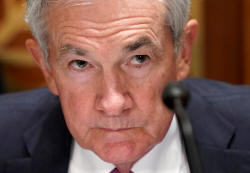Analysis-Fed's bond-buying program may be on the way out, but it's not
going far
 Send a link to a friend
Send a link to a friend
 [September 24, 2021] By
Howard Schneider [September 24, 2021] By
Howard Schneider
WASHINGTON (Reuters) - The Federal Reserve
will start to shutter its pandemic-era bond-buying program later this
year, leaving the U.S. central bank with a balance sheet of more than
$8.5 trillion before the purchases end in mid-2022 and a likely debate
coming about what to do different next time.
The quick answer may be nothing: By roughly doubling the size of its
securities holdings since the start of the pandemic in early 2020, the
Fed helped stabilize financial markets, used its ongoing purchases to
signal it would battle the economic crisis for as long as necessary, and
has now planned its wind-down with no market "tantrum."
Fed Chair Jerome Powell, speaking to reporters on Wednesday after the
end of a two-day policy meeting, said the central bank would start
paring its $120 billion in monthly asset purchases "soon" and end them
by the middle of next year.

"It served its purpose," said Tom Garretson, senior portfolio strategist
at RBC Wealth Management.
The bigger issue, Garretson and others noted, is that beyond the initial
impact on financial markets, it's not certain the Fed's bond-buying, or
"quantitative easing" as it's known in monetary policy circles, would
have been enough to offset last year's deep, if short, recession without
the massive government spending that was authorized by Congress.
The takeaway? Monetary policy run by the Fed and fiscal programs
implemented by elected officials will need to pull together in future
recessions as well.
"The dominant lesson ... is that the tools of the Federal Reserve and
other central banks are substantially inadequate for dealing with a
material weakening of economic activity, and fiscal policymakers need to
recognize that," said David Wilcox, former head of the Fed's research
division and now a senior fellow at the Peterson Institute for
International Economics.
UNCONVENTIONAL NO LONGER
Both the Fed's crisis response and some of the fiscal aid out of
Washington are now set to shrink, which could act as a drag on an
economy still emerging from the pandemic, with growth expected to slow
in 2022 after a healthy rebound this year.
But those programs did produce some unexpectedly fortunate results,
notably an increase in household incomes and wealth and a drop in
poverty despite the recession.

For the Fed, the pandemic cemented its once "unconventional" purchases
of U.S. Treasury bonds and mortgage-backed securities as a core part of
monetary policy, the preferred way to continue helping the economy once
the central bank's benchmark overnight interest rate, or federal funds
rate, has been cut to zero.
Other programs broadened, temporarily, the type of securities the Fed
could buy to include municipal and corporate bonds.
At a congressional hearing on Thursday, Roosevelt Institute economist
Mike Konczal said that should be a permanent part of Fed policy.
Those efforts "were more successful than people realize," in holding
down borrowing costs for local governments and companies, Konczal said,
and are "an evolution of unconventional monetary policy ... that is
likely to stay with us."
Other central banks have already broadened the assets they can purchase
beyond securities issued and backed by governments.
The scale and length of Fed purchases during the pandemic did vex some
elected officials, while some policymakers felt the program was
providing little benefit in recent months.
(GRAPHIC: The Fed's climbing balance sheet -
https://graphics.reuters.com/
USA-FED/TAPER/egpbkyjnrvq/
chart.png)
[to top of second column] |

Federal Reserve Chair
Jerome Powell takes his seat to testify before a Senate Banking,
Housing and Urban Affairs Committee hearing on “The Semiannual
Monetary Policy Report to the Congress” on Capitol Hill in
Washington, U.S., July 15, 2021. REUTERS/Kevin Lamarque/File Photo

That may argue for more flexibility during the next crisis around how and when
to end the asset purchases.
The Fed's pandemic-driven QE was tied tightly to the performance of the job
market. With the labor market healing more slowly than the economy as a whole,
and inflation now a concern, "they needed an escape hatch," said William
English, a Yale School of Management professor and former head of the Fed's
monetary affairs division.
ANNOUNCEMENT EFFECTS
QE entered the lexicon of U.S. monetary policy in 2009 as part of then-Fed Chair
Ben Bernanke's response to the 2007-2009 financial crisis and recession.
The Fed, unlike the European Central Bank, has not wanted to resort to using
negative interest rates to stimulate the economy, so once the "zero lower bound"
of the federal funds rate is reached it uses bond purchases to further lower the
cost of credit. That encourages purchases of homes, autos and other items that
involve longer-term loans, and can raise asset prices and contribute to
wealth-effect spending, too.
Just how effective it is, and what risks it may pose, remains a subject of
debate.
Fed staff and policymakers on their own have published nearly 80 papers since
2009 arguing about the advantages, limits and risks of QE. The general
conclusion is that it helps particularly early in a crisis when the mere
announcement of central bank support can lift confidence and over time help
anchor interest rates.

One indicator of that impact, what's known as the shadow federal funds rate
https://www.atlantafed.org/cqer/
research/wu-xia-shadow-federal-funds-rate, is currently estimated at -1.8%, in
effect where the Fed's target rate would need to be to produce the current
levels of bond yields.
(GRAPHIC: The Fed's "shadow rate" and QE - https://graphics.reuters.com/USA-FED/QE/klvykgnxxvg/chart.png)
One of the reasons it may be hard for the Fed to deviate much from the way it
did QE during the pandemic is precisely because it is the early promise of
open-ended support that seems to be a chief benefit.
The details may differ next time. Policymakers disagree, for example, over the
mix of monthly asset purchases - split between $80 billion of Treasury
securities and $40 billion of mortgage-backed assets - at a time when home
prices are skyrocketing.
But if the pandemic proved anything, it's that scale matters and that it's
better to plan for the worst and be surprised on the upside. The pandemic looked
like a long-lasting, Great Depression-level event in March 2020, when the U.S.
central bank slashed the federal funds rate to near zero and made an open-ended
commitment to purchase assets that raised its holdings of securities from $3.8
trillion to around $5.9 trillion by late May of that year.
"We can all complain about (QE) being imprecise and not being quite sure how it
works and not being sure how much it works," said Cornerstone Macro economist
Roberto Perli.

"But what is the alternative?" Perli said. Come the next recession "you most
likely will have to do it again in a decent size and with the same general
composition."
(Reporting by Howard Schneider; Editing by Dan Burns and Paul Simao)
[© 2021 Thomson Reuters. All rights
reserved.] Copyright 2021 Reuters. All rights reserved. This material may not be published,
broadcast, rewritten or redistributed.
Thompson Reuters is solely responsible for this content. |